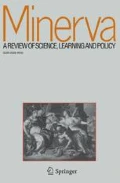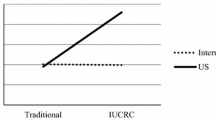Abstract
Over the course of the 20th century, unprecedented growth in scientific discovery was fueled by broad growth in the number of university-based scientists. During this period the American undergraduate enrollment rate and number of universities with STEM graduate programs each doubled three times and the annual volume of new PhDs doubled six times. This generated the research capacity that allowed the United States to surpass early European-dominated science production and lead for the rest of the century. Here, we focus on origins in the organizational environment and institutional dynamics instead of conventional economic factors. We argue that three trends of such dynamics in the development of American higher education not often considered together—mass undergraduate education, decentralized founding of universities, and flexible mission charters for PhD training—form a process characterized by a term coined here: access symbiosis. Then using a 90-year data series on STEM PhD production and institutional development, we demonstrate the historical progression of these mutually beneficial trends. This access symbiosis in the U.S., and perhaps versions of it in other nations, is likely one critical component of the integration of higher education development with the growing global capacity for scientific discovery. These results are discussed in terms of the contributions of American universities to the Century of Science, recent international trends, and its future viability.





Similar content being viewed by others
Notes
Because articles earlier in the century more frequently did not include institutional addresses for authors than later, it is possible that university-based authors are underestimated from 1900 to 1930.
There are many 4- and 2- year undergraduate colleges that also schooled the rise in undergraduate, but without graduate training.
References
Ashkenas, Jeremy, Haeyoun Park, and Adam Pearce. 2017. “Even with affirmative action, Blacks and Hispanics are more underrepresented at top colleges than 35 years ago.” The New York Times.
Baker, David P. 2014. The schooled society: The educational transformation of global culture. Stanford: Stanford University Press.
Ben-David, Joseph. 1977. Centers of learning: Britain, France, Germany, United States. Berkeley: The Carnegie Foundation for the Advancement of Teaching.
Berelson, Bernard. 1960. Graduate education in the United States. New York: McGraw-Hill.
Berkovitch, Nitza, and Karen Bradley. 1999. The globalization of women’s status: Consensus/dissensus in the world polity. Sociological Perspectives 42(3): 481–498.
Bowen, William G., and Neil L. Rudenstine. 1992. In pursuit of the PhD. Princeton: Princeton University Press.
Brint, Steven. 2019. Two cheers for higher education: Why American universities are stronger than ever—and how to meet the challenges they face. Princeton: Princeton University Press.
Cantwell, Brendan, and Barrett J. Taylor. 2013. Global status, intra-institutional stratification and organizational segmentation: A time-dynamic tobit analysis of ARWU position among U.S. universities. Minerva 51(2): 195–223.
Carnegie Foundation for the Advancement of Teaching. 2012. Carnegie Classifications Data File.
Clark, Burton. 1995. Places of inquiry: Research and advanced education in modern universities. Berkeley: University of California Press.
de Solla Price, Derek J. 1963. Little science, big science, and beyond. New York: Columbia University Press.
Dusdal, Jennifer. 2018. Welche Organisationsformen produzieren Wissenschaft? Zum Verhältnis von Hochschule und Wissenschaft in Deutschland. Germany: Campus Verlag.
Dusdal, Jennifer, Justin J.W. Powell, David P. Baker, Yuan-Chih Fu, Yahya Shamekhi, and Manfred Stock. 2020. University vs. research institute? The dual pillars of German science production, 1950–2010. Minerva 58(3): 319–342.
Fernandez, Frank, and David P. Baker. 2017. Science production in the United States: An unexpected synergy between mass higher education and the super research university. In The century of science: The global triumph of the research university, eds. Justin J.W. Powell, David P. Baker, and Frank Fernandez, 85–111. Bingley, United Kingdom: Emerald.
Fu, Y. C., David P. Baker, and L. Zhang. 2018. Engineering a world class university? The impact of Taiwan’s world class university project on scientific productivity. Higher Education Policy 1–16.
Geiger, Roger L. 1988. American foundations and academic social science, 1945–1960. Minerva 26(3): 315–341.
Geiger, Roger L. 1993. Research and relevant knowledge: American research universities since World War II. Oxford: Oxford University Press.
Geiger, Roger L. 1997. What happened after Sputnik? Shaping university research in the United States. Minerva 35(4): 349–367.
Geiger, Roger L. 2016. The history of American higher education: Learning and culture from the founding to World War II. Princeton: Princeton University Press.
Guston, David H., and Kenneth Keniston (eds.). 1994. The fragile contract: University science and the federal government. Cambridge: MIT Press.
Hearn, James C., and Kelly Ochs Rosinger. 2014. Socioeconomic diversity in selective private colleges: An organizational analysis. Review of Higher Education 38(1): 71–104.
Hogan, David. 1996. ‘To better our condition’: Educational credentialing and ‘the silent compulsion of economic relations’ in the United States, 1830 to the present. History of Education Quarterly 36(3): 243–270.
Hout, Michael. 1984. Status, autonomy, and training in occupational mobility. American Journal of Sociology 89(6): 1379–1409.
Hunter, Dupree A. 1988. Asa Gray, American botanist, friend of Darwin. Baltimore: Johns Hopkins University Press.
Jencks, Christopher, and David Riesman. 1968. The academic revolution. New York: Doubleday.
Kennedy, Michael D. 2014. Globalizing knowledge: Intellectuals, universities, and publics in transformation. Stanford: Stanford University Press.
Kim, Hyerim. 2019. The expansion of science production at Korean universities, 1970–2017 (Doctoral dissertation). Available from ProQuest Dissertations & Theses Global database. (UMI No. 28123310).
Labaree, David F. 2017. A perfect mess: The unlikely ascendancy of American higher education. Chicago: University of Chicago Press.
Leslie, Stuart W. 1993. The Cold War and American science: The military-industrial-academic complex at MIT and Stanford. New York: Columbia University Press.
Marginson, Simon. 2016b. The dream is over. The crisis of Clark Kerr’s California idea of higher education. Oakland: University of California Press.
Marginson, Simon. 2016a. The worldwide trend to high participation higher education: Dynamics of social stratification in inclusive systems. Higher Education 72(4): 413–434.
Marginson, Simon, and Gary Rhoades. 2002. Beyond national states, markets, and systems of higher education: A glonacal agency heuristic. Higher Education 43(3): 281–309.
Meyer, John W. (ed.). 1979. National development and the world system: Educational, economic, and political change, 1950–1970. Chicago: University of Chicago Press.
Meyer, John W., and Evan Schofer. 2007. The university in Europe and the world: Twentieth century expansion. In Towards a multiversity? Universities between Global Trends and National Traditions, eds. Georg Krücken, Anna Kosmützky, and Marc Torka, 45–62. Bielefeld: Transcript.
Millett, Catherine M. 2003. How undergraduate loan debt affects application and enrollment in graduate or first professional school. Journal of Higher Education 74(4): 386–427.
Nam, Seung Wan. 2020. An assessment of the impact of the Center of Excellence program on the research production of Korean universities from 1989 to 2011 (Unpublished doctoral dissertation). The Pennsylvania State University, State College, PA, United States.
National Center for Education Statistics. 2005. Digest of Education Statistics. Retrieved from https://nces.ed.gov/pubs2001/proj01/tables/tableB_04.asp.
National Center for Education Statistics. 2010. Digest of education statistics. Retrieved from https://nces.ed.gov/programs/digest/d15/tables/dt15_306.10.asp.
National Science Foundation. 2006. U.S. doctorates in the 20th century (NSF 06-319). Arlington: National Science Foundation, Division of Science Resources Statistics.
National Science Foundation. 2017. 2015: Doctorate recipients from U.S. universities. National Center for Science and Engineering Statistics, Directorate for Social, Behavioral and Economic Sciences. Retrieved from https://www.nsf.gov/statistics/2017/nsf17306/static/report/nsf17306.pdf.
Posselt, Julie R., Ozan Jaquette, Rob Bielby, and Michael N. Bastedo. 2012. Access without equity: Longitudinal analyses of institutional stratification by race and ethnicity, 1972–2004. American Educational Research Journal 49(6): 1074–1111.
Powell, Justin J.W., David P. Baker, and Frank Fernandez (eds.). 2017. The Century of Science: The Global Triumph of the Research University (Volume 33: International Perspectives on Education and Society Series). Bingley, UK: Emerald.
Powell, Justin J.W., and Heike Solga. 2011. Why are higher education participation rates in Germany so low? Institutional barriers to higher education expansion. Journal of Education and Work 24(1–2): 49–68.
Ramirez, Francisco O., and Dijana Tiplic. 2014. In pursuit of excellence? Discursive patterns in European higher education research. Higher Education 67(4): 439–455.
Schofer, Evan, and John W. Meyer. 2005. The worldwide expansion of higher education in the twentieth century. American Sociological Review 70(6): 898–920.
Schofer, Evan, Julia C. Lerch, and John W. Meyer. 2019. Illiberal Reactions to the University in the 21st Century. Paper presented at the annual meeting of the American Sociological Association, New York, August 10–13.
Simpson, Renate. 1983. How the PhD came to Britain. A century of struggle for postgraduate education (SRHE Monograph 54). Guildford, England: Society for Research into Higher Education.
Smith, Bruce L.R. 1990. American science policy since World War II. Washington, DC: Brookings Institution Press.
Snyder, Thomas D. 1993. 120 Years of American Education: A Statistical Portrait. Washington, D.C.: U.S. Dept. of Education, Office of Educational Research and Improvement, National Center for Education Statistics.
Stephan, Paula E. 2012. How economics shapes science. Cambridge: Harvard University Press.
Taylor, Barrett, and Brendan Cantwell. 2015. Global competition, U.S. research universities, and international doctoral education: Growth and consolidation of an organizational field. Research in Higher Education 56(5): 411–441.
Trow, Martin. 2007. Reflections on the transition from elite to mass to universal access: Forms and phases of higher education in modern societies since WWII. In International handbook of higher education, eds. James F. Forest and Philip G. Altbach, 243–280. Dordrecht: Springer.
Trow, Martin. 2010. Federalism in American higher education. In Twentieth-century higher education: Elite to Mass to Universal, ed. Michael Burrage, 177–207. Baltimore: Johns Hopkins University Press.
U.S. National Resources Committee. 1938. Research: A national resource. Washington, DC: United States Government Printing Office.
Williams, Roger L. 2018. Evan Pugh’s Penn State: America’s model agricultural college. State College: Penn State Press.
Woodrow Wilson National Fellowship Foundation. 2005. Diversity and the PhD: A review of efforts to broaden race & ethnicity in U.S. doctoral education. Princeton: Woodrow Wilson National Fellowship Foundation.
Yudkevich, Maria, Philip G. Altbach, and Laura E. Rumbley (eds.). 2016. The global academic rankings game. New York: Routledge.
Zhang, Liang, Liang Sun and Wei Bao. 2017. The rise of higher education and science in China. In The century of science: The global triumph of the research university, eds. Justin J.W. Powell, David P. Baker, and Frank Fernandez, 141–172. Bingley: Emerald.
Acknowledgments
The authors thank the Center for the Study of Higher Education and Social Science Research Institute at Penn State University, the SPHERE research collaborative, The Spencer Foundation, and the National Science Foundation for support in the obtaining and housing of the SED data; Lisa Broniszewski for data security compliance; and, Roger Geiger, David Guthrie, Kelly Rosinger, Royel Johnson, Karen Paulson, John Cheslock, Alicia Dowd and the Baker-Schaub lab group for comments on earlier drafts.
Author information
Authors and Affiliations
Corresponding author
Additional information
Publisher's Note
Springer Nature remains neutral with regard to jurisdictional claims in published maps and institutional affiliations.
Rights and permissions
About this article
Cite this article
Fernandez, F., Baker, D.P., Fu, YC. et al. A Symbiosis of Access: Proliferating STEM PhD Training in the U.S. from 1920–2010. Minerva 59, 79–98 (2021). https://doi.org/10.1007/s11024-020-09422-5
Accepted:
Published:
Issue Date:
DOI: https://doi.org/10.1007/s11024-020-09422-5




